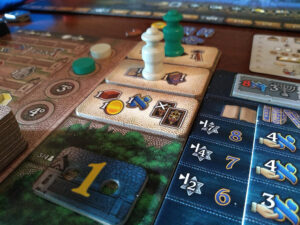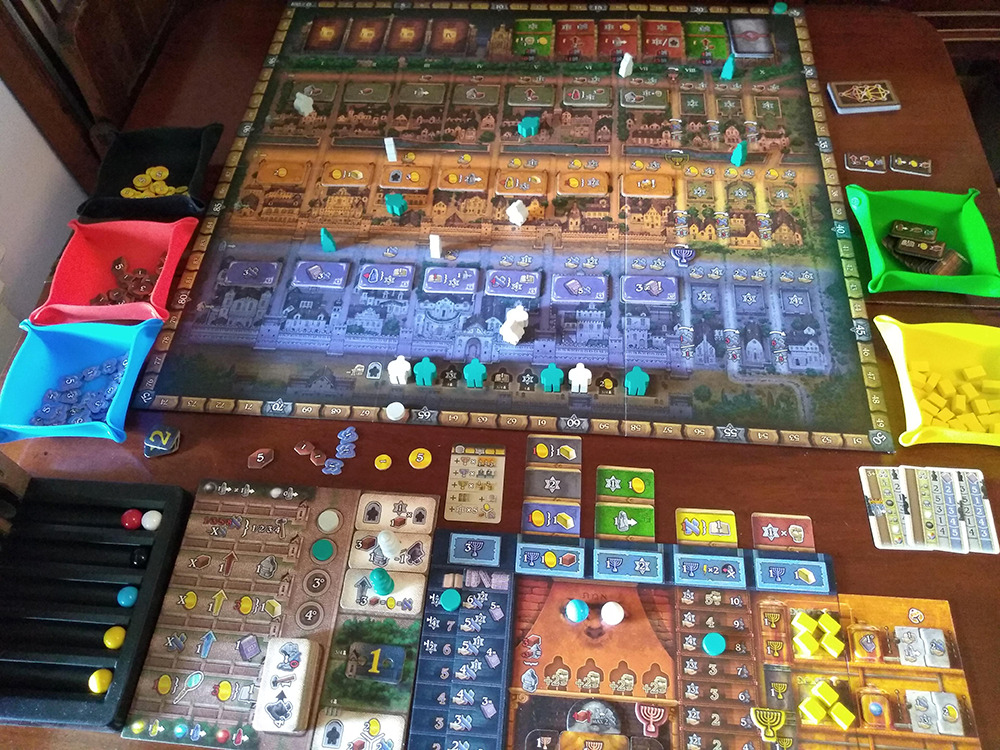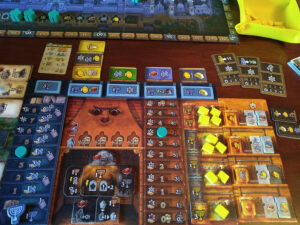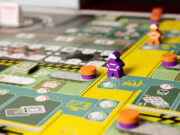 The Italians have done it again. No, not the Mario Bros. Not the Corleones. I’m talking about the group of Italian game designers who’ve been churning out quality Euros for several years now. Golem’s designers, Simone Luciani, Virginio Gigli, and Flaminia Brasini, have contributed to standout games like Tzolk’in, Grand Austria Hotel, Lorenzo il Magnifico, and Barrage in various combinations, along with a few other compatriots, such as Daniele Tascini.
The Italians have done it again. No, not the Mario Bros. Not the Corleones. I’m talking about the group of Italian game designers who’ve been churning out quality Euros for several years now. Golem’s designers, Simone Luciani, Virginio Gigli, and Flaminia Brasini, have contributed to standout games like Tzolk’in, Grand Austria Hotel, Lorenzo il Magnifico, and Barrage in various combinations, along with a few other compatriots, such as Daniele Tascini.
Golem is a strategic engine-builder for 1-4 rabbis that plays in about 2 hours, give or take some AP. But let’s get real, you’re here because you are a lone wolf rabbi and you want to know if the solo mode is any good.
Gameplay Overview:
In Golem, you are a rabbi creating golems and sending them out to work, directing students to control the golems, collecting books of knowledge, and crafting artifacts. The game plays out over the course of four rounds divided up into several phases. You begin the round by moving your golems along three tracks, depicted as streets passing through different districts in Prague. The positions of those golems determine some of the benefits you will have access to later in the round.

Next, players take turns performing three actions each, divided into two marble actions and one rabbi action. To perform a marble action, you’ll remove a colored sphere from the synagogue. The row you draw from determines which action you take, such as sending your golems to work, creating new golems, crafting artifacts, or buying books. The marble’s color allows you to move a student along the street in the corresponding district. Taking a rabbi action means you choose from one of the available action tiles for the current round.
Once everyone has taken their turns, players may gain an extra benefit by influencing the current Character if they have chosen the relevant marbles during the round. Next, players earn income from their students’ positions on the district tracks and from their player boards, where things like study, golem creation, and artifact crafting pay off. The final step of a round is to pay knowledge so that your students can exert control over the golems in their districts. If you fall short and can’t pay the knowledge, you’ll lose victory points.

Game Experience:
The solo mode features a bot opponent, the Great Automa, that does an excellent job of emulating a human player. The bot gains and pays resources, takes marble and rabbi actions, moves golems, and generally behaves like a multiplayer opponent. The primary difference is that the Automa treats all three main resource types the same, tracking the total on a special resource board rather than collecting individual tokens like a human.
The solo rules provide decision trees for the Automa to follow so that its choices are clear when performing an action. The Automa will generally make human-like decisions when choosing things like which development to upgrade, which golems to move, or where to place a purchased book. There is a bit of a learning curve to running the Automa as it can take some time to internalize the choices the bot wants to make in each situation. This is especially true if you’re learning the game yourself; so, the first play could have a few stumbles where you realize along the way you’ve been playing something wrong. But the time taken to learn the Automa will be well worth the effort.

While some solo bots have their behavior completely randomized and abstracted to make it impossible to predict what they’ll do on their turn, the Golem Automa’s choices follow patterns that a savvy player can take advantage of. One important aspect of the game is timing your actions, particularly so that you can chain together satisfying combos. Players will often need to carefully order their choices so that they can obtain the resources or conditions necessary to carry out their grand strategies. With only 12 turns in the game, you’ll need to maximize the efficiency of individual plays so that you’re doing as much as possible each time you act.
Against human players, you can’t read minds, but you can scan their resource piles and player boards, deducing certain things from their overall behavior and perceivable strategy. Are they clearly pushing to build artifacts and need only one gold to complete a juicy, artifact development slot? Then maybe they won’t take the Golem action you need and you can spend an extra turn gathering resources to maximize that play. Timing is crucial to strengthening your score in Golem.
The AI is run by a deck of cards that direct the Automa’s decision making. The bot chooses its action each turn by flipping a card from the Automa deck, which will indicate that it either wants to take a marble action or a rabbi action.

If it wishes to take a marble action, there is a column of criteria through which it will pass in order to decide which marble to select. The Automa tends to prefer the Work action (allowing it to trigger lots of benefits) or the row with the most marbles. If it already has a marble of one of the colors on the Character card, it won’t take that color again. It really wants to influence that Character and gain the bonus.
The Automa chooses to take a rabbi action either when the rabbi meeple icons match up to create a complete picture, or when the leftmost action selection column dictates. In either case, the Automa again has a tendency, preferring one of the uppermost action tiles, because it wants the first player position.
Knowing these tendencies and preferences allows the solo player to guess which action the Automa ‘might’ take on a given turn, but there’s always the chance it will go off script and pick an unexpected marble or rabbi action tile. These same types of probability exist when playing against human players. For me, the sign of a strong solo bot is one that doesn’t behave completely randomly but can be anticipated to a certain degree when informing your own tactics. But, just like a human opponent, the Automa might act unexpectedly and therefore cannot be perfectly predicted.
All that being said, although the Automa does a wonderful job of replicating a human opponent, it doesn’t do a great job of emulating a strong adversary. The bot in Golem has four levels of difficulty. This level mostly impacts the amount of the Automa’s starting resources, when it chooses not to spend resources, how many points it scores from endgame objective cards, and some additional bonuses provided on the flipped Automa card each turn.

A significant portion of a final score in Golem comes from multiplying collected menorahs by the number of completed elements in an area. While the strategy tiles give it an area to focus on, there are times when the Automa fails to ramp up its engine to the point where it has maxed out the potential of one of the three primary scoring areas. This means that it can struggle to compete with a smart solo player.
While the bot’s decision tree tends towards taking the best short-term option, it obviously doesn’t have the long-term strategic thinking capabilities that would allow it to fully maximize its score. For instance, the Automa cards will lean towards taking a marble from the row with the most marbles. But the better option might be to draw from a row with one fewer marble (really only marginally inferior), allowing for completion of an artifact that will begin earning extra income this round. Card-based solo AI isn’t sophisticated enough to perceive these minute strategic implications and therefore goes with what appears to be the most beneficial action in the here and now. But one more resource now is strictly worse, of course, than an extra six resources and two points right after this turn.
Final Thoughts:
Golem is an excellent strategy game with loads of depth, allowing you to explore multiple viable avenues to success. With a highly variable setup and in-game options that differ considerably from play to play, the game provides strong replayability. The Automa does a great job of filling in for a living opponent, but it does take a few plays to master running the bot. If you enjoy deep decision-making and want a game that will reward strategic planning, Golem will hit the spot.
Final Score: 4.5 Stars – Crunchy engine-builder with a unique theme and a satisfying, human-like solo bot.
 Hits:
Hits:
• Solo AI replicates human players
• Lots of interesting decisions
• High replay value
• Theme is fresh and distinctive
Misses:
• Learning curve to running Automa
• Lack of AI challenge



















